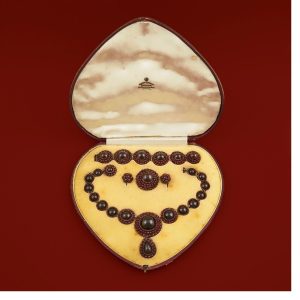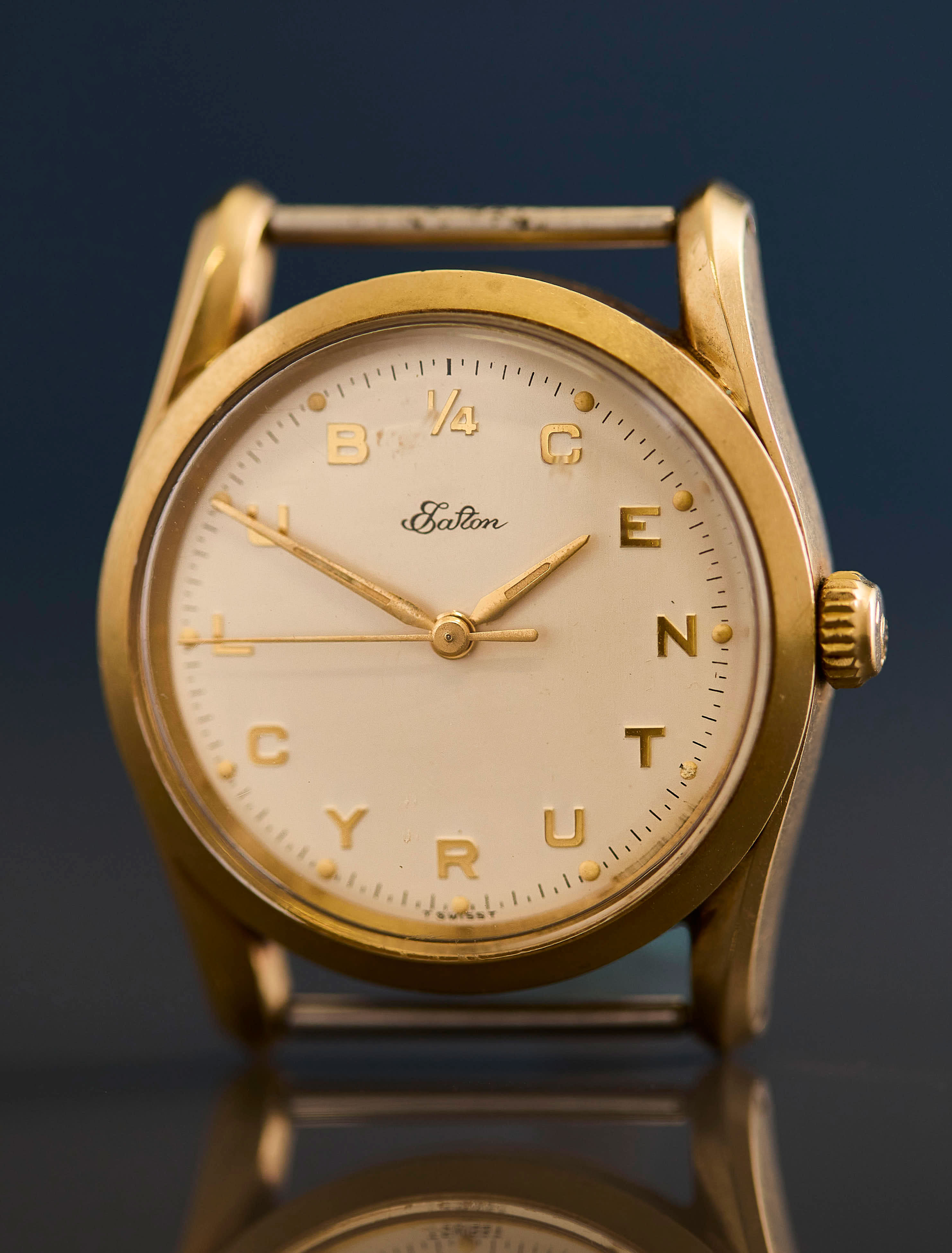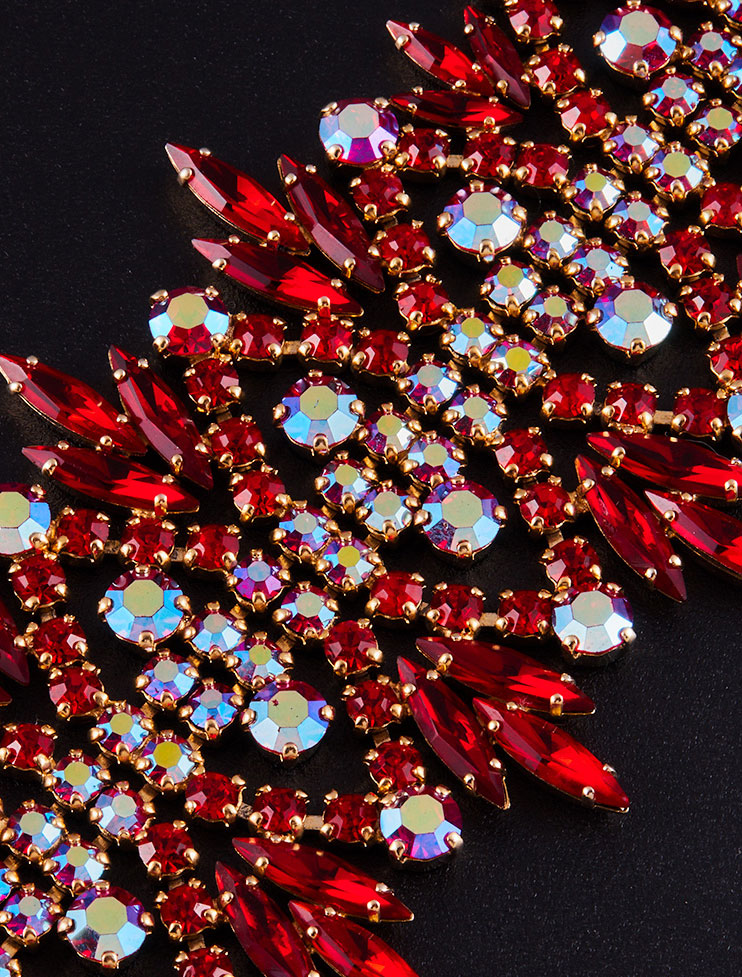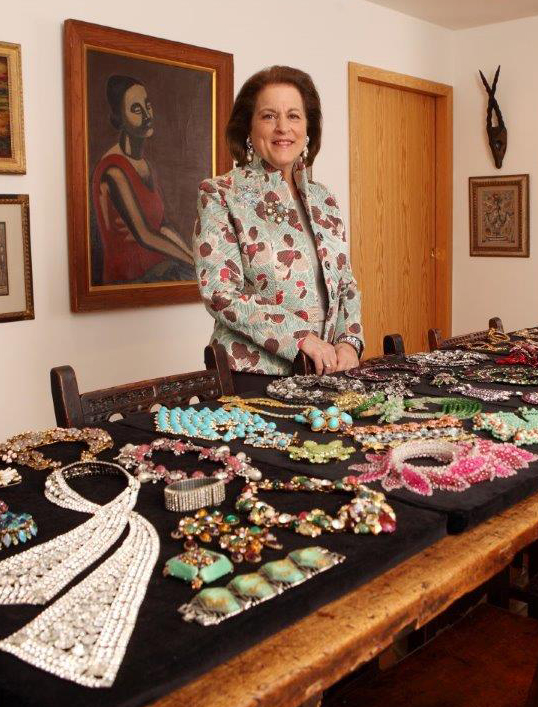
comprising a bracelet, a necklace, a brooch and earrings; length 15 in — 38.1 cm; length 6.5 in — 16.5 cm. 6 garnets absent; several areas of repairs and restorations, brooch condition noted; gold chain extension added to necklace; in the original fitted box; 15″; 6.5″. Estimate $1,000-$1,500
“Bohemian garnets” might conjure impressions of flower-child style, but did you know that the term actually refers to a very specific stone from a very specific place?
Garnets are silicate minerals formed under high pressure and temperature. The term ‘garnet’ actually encompasses several varieties of gemstones, including Almandine, Pyrope, Spessartine, Grossular, Uvarovite, and Andradite. The word ‘garnet’ is thought to derive from the Latin ‘garanatus’, meaning ‘seedlike.’
While garnets can come in a range of colours, strictly speaking, true Bohemian garnets are dark red pyrope crystals, mined from the Bohemia region located in the present-day Czech Republic. Bohemian garnets are often compared to pomegranate seeds, in both hue, gloss and size – the majority rarely exceed 5-6 mm. Bohemia produced both an abundance of deep red gemstones, as well as a style of jewellery which reached its greatest popularity during the late Victorian era – which is why you may see garnets sourced from other regions referred to as Bohemian when they are styled in the Czech fashion.
A BRIEF HISTORY OF BOHEMIAN GARNETS
Bohemia, which derived its name from the Celtic “Boii” people, has a rich history of gems and jewellery-making, dating back to the early Iron Age. Local garnets were used as personal ornaments by the early Celts, and were traded by Germanic tribes in the 5th and 6th centuries. Some of the earliest garnet-encrusted artefacts – including weapons, apparel and footwear – were excavated from the tomb of the Frankish King Childeric I (436-481 AD) at Tournai, Belgium.
These early gems were probably found in the topsoil, or panned from riverbeds; scholars suggest that mining began sometime between the 11th and 15th century. Over the centuries, garnets were worn by nobility, royalty, and clergy, as well as being used to decorate liturgical and decorative objects. The Middle Ages and Renaissance periods saw an increased interest in Bohemian garnets, which were often mounted in clusters or embellished with other gemstones to compensate for their small size.
Significant garnet deposits were found in Bohemia around the early 16th century. Rudolph II, the Holy Roman Emperor and King of Hungary, Croatia, and Bohemia, encouraged gemcutters, goldsmiths and other artists and artisans to set up workshops in his newly established capital of Prague. This new abundance of gemstones, coupled with the belief that they had curative and protective powers spiked demand for Bohemian garnet jewellery.
Garnet jewellery reached its ultimate peak in the 19th century. It was estimated that by the 1890s, the Bohemian garnet industry employed some 10,000 people, from miners and workers to cutters and salespeople. The scale of the industry meant that garnet wearables became reasonably accessible to the average consumer – sometimes small stones were paired with glass imitations to render pieces even more affordable. This is not to say that it was a style only favoured by the general public – nobility, royalty and celebrities also adored jewellery made with this fiery stone.
Bohemian garnets fell out of fashion in the 20th century, owing to changing fashions. Post-war, mining for luxury gemstones was superseded by more pressing industrial concerns. However, a 21st century revival is well underway, as Czech artisans find new ways to showcase their local gemstone, and continue to practice an artform with centuries-old roots.
BOHEMIAN GARNET JEWELLERY
Valued for their clarity, Bohemian garnets were traditionally rose-cut and mounted in close-set pavé settings. They were designed to showcase as much of the stones’ surface as possible, with the aim of downplaying their metal mounts. These mounts were often made from less expensive metals, making them more affordable – which accounts for their great rise in popularity. Bohemian garnet jewellery is often designed to look like a pomegranate seed cluster.
Those born in January are lucky to have the timeless garnet as their birthstone – though those born in other months shouldn’t shy away from wearing this romantic gemstone!
ABOUT THE AUCTION
It is commonplace to come across Bohemian garnet jewellery in single pieces and less so as complete sets, which is why we are delighted to be offering lot 123, an intact garnet parure still ensconced in its original fitted box. This five-piece parure comprises a necklace, bracelet, brooch, and a pair of earrings, all set in an alluringly deep and rich tone of cabochon and rose cut garnets.
The auction is offered online September 17-22, 2022.
View the online gallery, and visit our public previews:
Sunday, September 18 from 12:00 pm to 4:00 pm
Monday, September 19 from 10:00 am to 7:00 pm
Tuesday, September 20 from 10:00 am to 5:00 pm
Please contact us for more information.
Related News
Meet the Specialists

Donald McLean
Senior Specialist

Livia Miliotis
Associate Specialist










